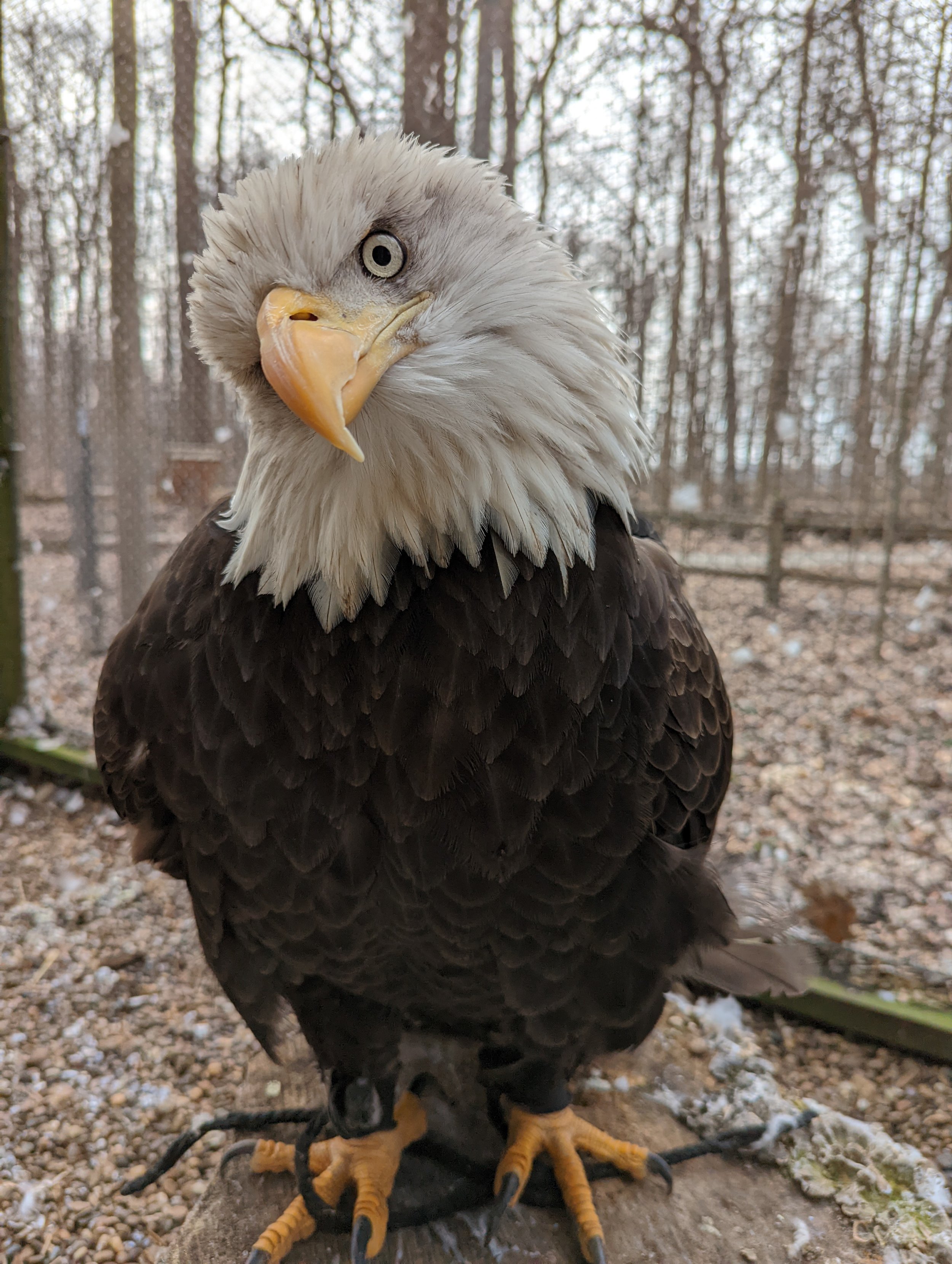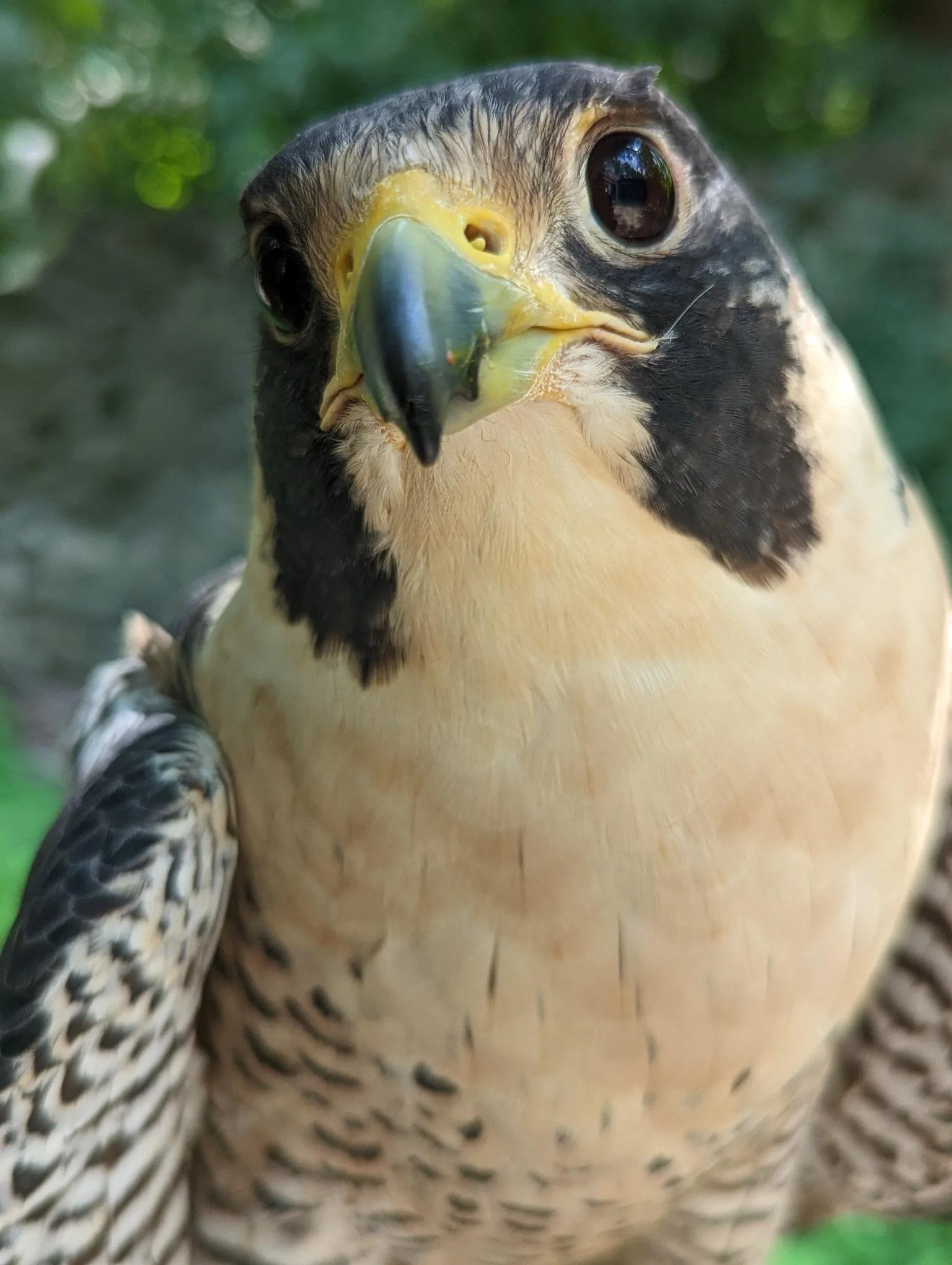Animal Ambassadors
All members of the ambassador animal team are non-releasable. They are not capable of surviving in the wild due to a physical injury and/or have a dependence on humans. Their primary role at Wesselman Woods is to assist in teaching the public about their species, biology, ecology, and conservation.
Animals are permitted through U.S. Fish and Wildlife Service (USFWS), U.S. Department of Agriculture (USDA), and the Indiana Department of Natural Resources (IDNR).
⚠️ The raptor building is getting MAJOR, necessary updates and improvements. ⚠️
During construction, our outdoor animal ambassadors will be off-display for their safety. The birds (and all of us humans!) are looking forward to upgraded facilities and larger enclosures before the end of the year.
Sybil - Bald Eagle (Haliaeetus leucocephalus)
Sybil was admitted to Southeastern Raptor Center at Auburn University in Auburn, AL on Feb. 17, 2012 with a gunshot wound resulting in a fracture of the right ulna. She found on the side of a road and was an adult at the time. After two years of rehab with physical therapy, she only has 85-90% of her normal range of motion in her right wing thus she cannot sustain flight. She joined Wesselman on April 10, 2014.
Like other bald eagles, Sybil enjoys being in water and eating fish. She can be very vocal sometimes, displaying a shrill, cackling call.
Location: Mews
Pearl - Turkey Vulture (Carthartes aura)
Pearl was admitted to West Sound Wildlife Shelter in Bainbridge Island, WA on Oct. 11, 2014. She was about 6 months old. She was thin, weak, cold, dehydrated, and wet. She was seen “falling from the sky” and was walking on the beach in Belfair, WA for 2-3 days. Her feathers were thin and malformed. She was full of lice and sand. Her left humerus was previously fractured midshaft and healed with “horrible alignment” and “complete overlap”. She joined Wesselman on May 6, 2015.
Pearl is curious and likes to open boxes and explore new objects. This activity reflects turkey vultures’ natural behavior of spending a lot of time on the ground to find and eat food.
Location: Mews
Izzy - Peregrine Falcon (Falco peregrinus)
Izzy was emaciated and immature when admitted to rehab. She was originally admitted to Hatteras Island Rehab and then transferred to Anita Yeattes in Disputanta, VA. She seemed to have sustained a fracture to her humerus in the nest. She has permanent tendon damage that prevents her from sustained fight over 100 yards. She was still in juvenile plumage when she arrived at Wesselman on July 1, 2016.
A few falcon-defining physical features are notable in the photo: the nasal tubercles (the yellow point inside her nostrils), the malar stripes on her cheeks (present in most but not all falcons), and the tomial “tooth” on her upper beak (the notch/step that helps them dispatch prey).
Location: Mews
Artemis - Eastern Screech Owl (Megascops asio)
Artemis was admitted to the University of Missouri on November 7, 2020 from Phelps County with a fractured right humerus after a car strike. The bone healed but the patagium (the soft tissue that forms the wing’s leading edge from the shoulder to wrist) contracted, inhibiting his flight ability. He arrived at Wesselman on December 16, 2021.
These owls are hard to spot in the wild due to their secretive nature, camouflage, and small size. It can be easier to hear them call to each other in the hours around dusk and dawn.
Location: Mews
Hattie - Great Horned Owl (Bubo virginianus)
Hattie had a collision with a car in central Indiana in the early 2000s. The left wing tip was damaged resulting in amputation. She cannot gain altitude in flight. Hattie is named after her rehabbers, Liz and Chris Hatton. She returned to Wesselman Woods on June 27, 2022.
Great horned owls are generalists, they are not picky eaters. Although mammals make up a large part of their diet, they will also eat insects. Hattie is no exception and insect exoskeletons can be occasionally found in her pellets. She loves to manipulate and shred objects.
Location: Mews
Chip - Barred Owl (Strix varia)
Chip was found on the ground near fledging in 2012 and rehabbed in Westfield, IN. He has a deformed foot so he cannot perch normally, hunt effectively, nor maintain his feathers properly. He came to Wesselman in October 2023.
Unlike our other resident owls, Chip has no ear tufts. These feathers are not involved in hearing. Owls’ real ears are located a little behind and below their eyes.
Location: Mews
Felix Lloyd - Eastern Grey Squirrel (Sciurus carolinensis)
Felix Lloyd was found and rehabilitated in South Elgin, IL by the Anderson Humane Society in February 2021. He was thrown off a roof during an incident with a hawk. His puncture wounds healed well but he sustained permanent head trauma. He came to Wesselman in May of that year and was named in honor of former Mayor Lloyd Winnecke for his birthday.
Squirrels are vital parts of forest regeneration; they plant and disperse a variety of seeds.
Location: Mews
Shelly (Chely) - Alligator Snapping Turtle (Macrochelys temminckii)
Chely was approximately 10 years old with a 10” carapace when she came to Wesselman on August 1, 2007. She was a pet obtained in another state. Chely’s species was never abundant in Indiana as the state lays on the north-most border of their natural range. They are state endangered.
Location: Small Classroom
Sheldon - Common Snapping Turtle (Chelydra serpentina)
Sheldon was a surrendered pet whose owners found him to be difficult once he matured. He has lived at the nature center before 2014.
Unlike alligator snappers, commons are readily found in shallow ponds and streams throughout this area.
Location: Small Classroom
Eastern Box Turtles (Terrapene carolina carolina)
Note: Box turtles are protected in Indiana. Collection and sale of wild box turtles, possession of their eggs and body parts (including shells) are illegal activities. These turtles are kept with permission from Indiana DNR.
Most of the eastern box turtles came to Wesselman after the Evansville Museum remodeled in 2008/2009.
Myrtle was donated on May 2, 2020. She was found as an adult in 1993/1994 and kept as a pet.
Jess was dropped off at the Vanderburgh Humane Society on May 18, 2019 with no information about her history. She was transferred to Wesselman on August 5, 2019.
Location: Lobby Enclosures
Eugene - Three-Toed Box Turtle (Terrapene carolina triunguis)
Eugene was kidnapped out of the wild and was brought to Wesselman Woods with quite a few medical issues. His original location is unknown as the finders refused to share the information. He was received February 18, 2014.
This subspecies can sometimes be found with four toes (instead of three) due to breeding with other subspecies.
Location: Large Classroom
Ssstevie - Garter Snake (Thamnophis sirtalis)
Ssstevie was born at Angel Mounds and hand-raised. He came to Wesselman as a juvenile in 2016.
Ssstevie loves to eat mice and minnows. Garter snakes will also eat insects, slugs, worms, and amphibians.
Location: Lobby Display Wall
Roscoe - Central Rat Snake (Pantherophis alleghaniensis)
Roscoe was hand-raised and grew up at Wesselman Woods. We believe he was hatched around 2007.
He is an excellent climber, using his body and belly scales to grip vertical surfaces like trees.
Location: Large Classroom
Larry - Eastern Kingsnake (Lampropeltis getula)
Larry was found on one of the coldest winter days in January 2015 in a long-time volunteer’s basement. He was brought to Wesselman Woods with feline damage to his underside and prolonged stay due to subsequent infection.
Kingsnakes have high resistance to venoms from local venomous snakes they share their habitat with. They can eat venomous snakes in addition to other animals.
Location: Lobby Display Wall
Achoo
Cornsnakes (Pantherophis guttatus)
Pebble
Achoo was added to the Wesselman team in 2014. She was captive-raised, had become very obese at her previous home, and is slowly returning to a normal weight. She is content to quietly watch the world around her.
Pebble was a surrendered pet and was donated to Wesselman in October 2014. He/she was raised in captivity, is very curious, and always ready to explore.
Corn snakes are closely related to our native central rat snakes and are sometimes called red rat snakes.
Location: Large Classroom
Garface a.k.a. Lady GarGar - Spotted Gar (Lepisosteus oculatus)
Garface was received from Mesker Zoo. He was caught in the wild in 2005. He is nocturnal but can be observed hunting minnows if the room is quiet and dark.
His diamond-shaped scales are covered in a hard, enamel-like coating. These ganoid scales are found in primitive fish like gars, bowfins, and paddlefish.
Location: Large Classroom

























